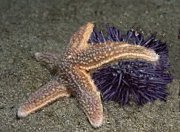
Whenever you go down to the beach you know that you will probally see starfish either on the beach, rock pools or the rocks themselves. Starfish would be one of the most popular creatures there.
Starfish are found through out New Zealand. They live in the tidal zone, rock pools and in the great depths.
Starfish have a central disc from which five or more arms radiate. They are spiny hard-skinned animals. (Did you know that If a arm is lost or broken off the starfish in some way, it will regenerate (regrow).
Starfish are invertebrates, NOT fish.
Starfish would be classed as an unusual creature, because you could say that they have no front or back, and they can move in any direction without turning.
Starfish move very slowly along the sea bed, using hundreds of tiny tube feet.
Beleive it or not starfish do not use muscles to move their hundreds of tiny legs, they use a complex hydraulic system to move around and cling to rocks. If you've ever tried to pull a starfish off a rock, you know how well this system works.
Most starfish are predators, they feed on slow-moving prey such as mollusks and barnacles. Other things like oysters, scallops, snails, worms, seaeggs (sea urchins), other fish, shrimps and old decaying matter. Some starfish in other parts of the world namely the crown-of-thorns starfish specializes on corals, and may do considerable damage to coral reefs.
Many starfish but not all, are able to turn a portion of their stomachs out through the mouth, and thus digest food outside of the body.
Starfish are not allways found sprawled out looking like stars, they can rearrange their arms any way they please thus they are able to wedge themselves into a small nook or crack in the rocks.
These animals are not fast movers, they are usually fairly sluggish, have five or six arms and get pretty stiff when you try to pick them up. There is one starfish though that has 20 arms, this one is called the Sunflower Star.
There are over 2,000 different species of Starfish worldwide.
Most of the species of starfish expel thousands of eggs and sperm into the ocean, fertilization is external.
The tiny, transparent larvae are swept along by the ocean currents for about two months, and in this time they travel many kilometres. As they develop, the tiny larvae swim in the sea.